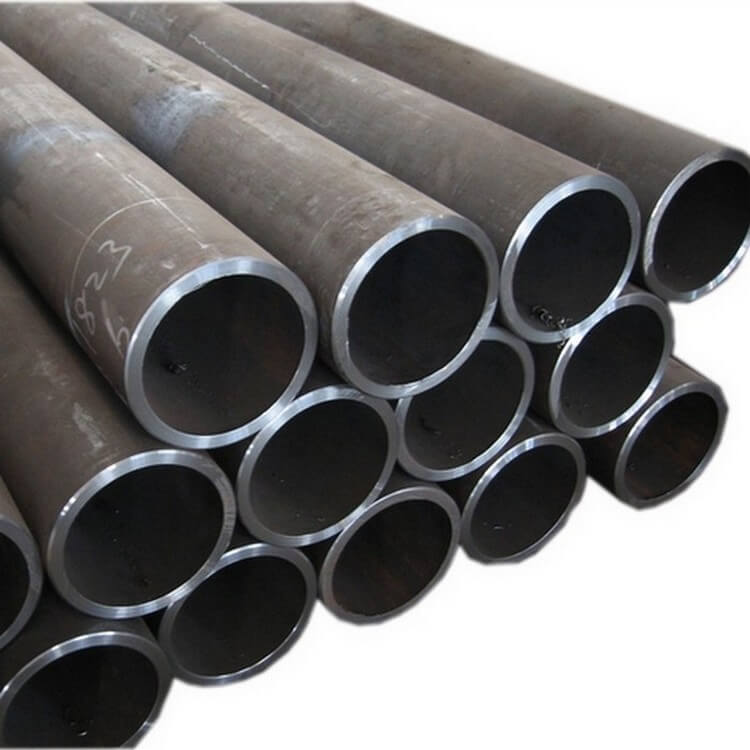Call Us: +86 15954941919 interested in Contact Us? Mail us now
English
Call Us: +86 15954941919 interested in Contact Us? Mail us now
English




The surface of the precision cylinder tube is cross-textured, which is conducive to the storage of lubricating oil and the maintenance of the oil film. It has a higher surface support rate (the ratio of the actual contact area of the hole and the shaft to the mating area between the two), so it can bear more Large load and wear resistance, thereby increasing the service life of the product. The honing speed is low (one tenth of the grinding speed), and the oil stone and the hole are in surface contact, so the average grinding pressure of each abrasive grain is small When honing, the heat of the workpiece is very small, the surface of the workpiece has almost no thermal damage and deterioration layer, and the deformation is small. The honing surface has almost no sand embedded and extruded hard layer.
High-precision steel pipe material
Cylinder tube is a kind of high-precision steel tube material processed by cold drawing or hot rolling. Since the inner and outer walls of the precision steel tube have no oxide layer, no leakage under high pressure, high precision, high finish, no deformation in cold bending, no flaring, no cracks in flattening, etc., it is mainly used to produce products for pneumatic or hydraulic components, such as cylinders or Cylinder, can be seamless pipe . The chemical composition of the cylinder tube is carbon C, silicon Si, manganese Mn, sulfur S, phosphorus P, chromium Cr.
Cylinder tube is a kind of high-precision steel tube material processed by cold drawing or hot rolling. Since the inner and outer walls of the precision steel tube have no oxide layer, no leakage under high pressure, high precision, high finish, no deformation in cold bending, no flaring, no cracks in flattening, etc., it is mainly used to produce products for pneumatic or hydraulic components, such as cylinders or Cylinder, can be seamless pipe . The chemical composition of the cylinder tube is carbon C, silicon Si, manganese Mn, sulfur S, phosphorus P, chromium Cr.
The cylinder tube is processed by rolling, because the surface layer has residual compressive stress on the surface, which helps to seal the tiny cracks on the surface and hinders the expansion of erosion. Therefore, the corrosion resistance of the surface can be improved, and the generation or expansion of fatigue cracks can be delayed, thereby improving the fatigue strength of the cylinder tube. Through roll forming, a cold work hardened layer is formed on the rolled surface, which reduces the elastic and plastic deformation of the contact surface of the grinding pair, thereby improving the wear resistance of the inner wall of the cylinder tube and avoiding burns caused by grinding. After rolling, the reduction of surface roughness value can improve the fit properties.
Rolling processing is a chip-free processing that uses the plastic deformation of metal at room temperature to flatten the microscopic unevenness of the workpiece surface to achieve the purpose of changing the surface structure, mechanical properties, shape and size. Therefore, this method can achieve two purposes of finishing and strengthening at the same time, which cannot be achieved by grinding.
No matter what kind of processing method is used, there will always be fine bump marks on the surface of the part, and the phenomenon of staggered peaks and valleys will appear.
The principle of rolling processing: it is a pressure finishing process, which uses the cold plastic characteristics of metal at room temperature, and uses a rolling tool to apply a certain pressure to the surface of the workpiece, so that the metal on the surface of the workpiece produces plastic flow and fills the original residue. In the low concave trough, the roughness value of the workpiece surface is reduced. Due to the plastic deformation of the rolled surface metal, the surface structure is cold hardened and the grains are thinned, forming a dense fibrous shape, and forming a residual stress layer, which improves the hardness and strength, thereby improving the wear resistance and corrosion resistance of the workpiece surface. Sex and cooperation. Rolling is a non-cutting plastic processing method.
1. Improve the surface roughness , the roughness can basically reach Ra≤0.08µm.
2. Correct the roundness, the ellipticity can be ≤0.01mm.
3. Improve surface hardness, eliminate stress and deformation, and increase hardness by HV≥4°
4. There is a residual stress layer after processing, which improves the fatigue strength by 30%.
5. Improve the quality of fit, reduce wear, and prolong the service life of parts, but the processing cost of parts is reduced.
1. The main feature of seamless steel pipe is that it has no welded seams and can withstand greater pressure. Products can be very rough as-cast or cold drawn.
2. The cylinder tube is a product that has appeared in recent years, mainly because the inner hole and outer wall have strict tolerances and roughness.
Features of the cylinder tube
1. The outer diameter is smaller.
2. High precision and small batch production
3. The cold drawn finished product has high precision and good surface quality.
4. The cross-sectional area of the steel pipe is more complicated.
5. The performance of the steel pipe is better and the metal is denser.
The hot-rolled cylinder tube is made of continuous casting round tube billet slab or pre-rolled slab as raw material, heated in a walking furnace, descaled by high-pressure water, and then enters the rough rolling mill. Computer-controlled rolling is implemented, and after final rolling, it is cooled by laminar flow and coiled by a coiler to become a straight hair coil. The head and tail of the straight hair curler are often tongue-shaped and fish-tail-shaped, with poor thickness and width accuracy, and the edges often have defects such as wave shape, folded edge, and tower shape. The coil weight is heavier, and the inner diameter of the steel coil is 760mm. After the straight hair coil is processed by cutting head, tail cutting, edge trimming and multi-pass straightening, leveling and other finishing lines, it is then cut or re-coiled to become: hot- rolled steel plate , flat hot-rolled steel coil, longitudinal Tape and other products. If the hot-rolled finishing coil is pickled to remove the oxide scale and oiled, it becomes a hot-rolled acid-washed coil.
10# 0.07~0.13 0.17~0.37 0.35~0.65 ≤0.035 ≤0.035
20# 0.17~0.23 0.17~0.37 0.35~0.65 ≤0.035 ≤0.035
35# 0.32~0.39 0.17~0.37 0.35~0.65 ≤0.035 ≤0.035
45# 0.42~0.50 0.17~0.37 0.50~0.80 ≤0.035 ≤0.035
40cr 0.37~0.44 0.17~0.37 0.50~0.80 ≤0.035 ≤0.035 0.08~1.10
25Mn 0.22~0.2 0.17~0.37 0.70~1.00 ≤0.035 ≤0.035 ≤0.25
37Mn5 0.30~0.39 0.15~0.30 1.20~1.50 ≤0.015 ≤0.020
The use of stainless steel material for the cylinder tube has the characteristics of light product design and long service life.
Because stainless steel has high strength and corrosion resistance, compared with aluminum, iron and other materials, due to its high strength and non-magnetic properties, it can be designed to be lighter and thinner than aluminum and iron, which can reduce the size and weight of the product, and is used for more mini cylinders . It is the first choice for lightweight automation equipment.
The inner and outer roughness of the stainless steel cylinder tube can reach Ra0.2-0.4μω, the inner and outer diameter tolerance zone can reach 0.03mm; the specifications are from Φ3--Φ108mm, and the wall thickness is 0.2-3mm.
material name | Inner diameter dimensional tolerance | Outer Diameter Tolerance | Concentricity | Cylindricity |
Stainless steel tube φ6 (7x0.5) | Φ6 (+0.04/-0) | Φ7 (+0.03/-0.03) | 0.02 | 0.04 |
Stainless steel tube φ8 (9x0.5) | Φ8(+0.04/-0) | φ9(+0.03/-0.03) | 0.02 | 0.04 |
Stainless steel tube φ10 (11x0.5) | φ10(+0.04/-0) | φ11(+0.03/-0.03) | 0.02 | 0.04 |
Stainless steel tube φ12 (13.4x0.7) | φ12(+0.05/-0) | φ13.4 (+0.05/-0) | 0.02 | 0.05 |
Stainless steel tube φ16 (17.4x0.7) | φ16(+0.05/-0) | φ17.4 (+0.05/-0) | 0.02 | 0.05 |
Stainless steel tube φ20 (21.4x0.7) | φ20(+0.05/-0) | φ21.4 (+0.05/-0) | 0.025 | 0.05 |
Stainless steel tube φ25 (26.4x0.7) | φ25(+0.05/-0) | φ26.4 (+0.05/-0) | 0.025 | 0.05 |
Stainless steel tube φ32 (33.6x0.8) | φ32(+0.06/-0) | φ33.6(+0/-0.05) | 0.03 | 0.06 |
Stainless steel tube φ40 (41.6x0.8) | φ40(+0.06/-0) | φ41.6(+0/-0.05) | 0.03 | 0.06 |
Stainless steel tube φ50 (52x1) | Φ50(+0.1/-0) | φ52(+0.1/-0.1) | 0.04 | 0.07 |
Stainless steel tube φ63 (65x1) | Φ63(+0.1/-0) | φ65(+0.1/-0.1) | 0.04 | 0.07 |
